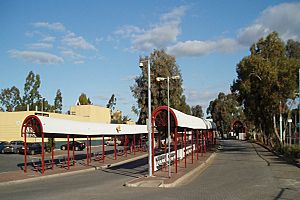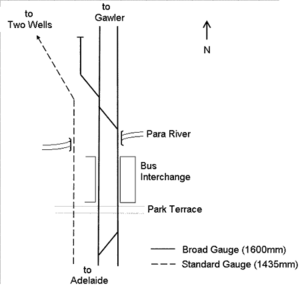Salisbury railway station, Adelaide facts for kids
Quick facts for kids
Salisbury
|
|||||||||||
|---|---|---|---|---|---|---|---|---|---|---|---|
| Railway station and bus interchange | |||||||||||

Salisbury railway station in June 2006
|
|||||||||||
| Location | Park Terrace, Salisbury | ||||||||||
| Coordinates | 34°45′47″S 138°38′33″E / 34.7631°S 138.6424°E | ||||||||||
| Owned by | Department for Infrastructure & Transport | ||||||||||
| Operated by | Adelaide Metro | ||||||||||
| Line(s) | Gawler | ||||||||||
| Distance | 20.2 km from Adelaide | ||||||||||
| Platforms | 2 | ||||||||||
| Bus routes | GA1, GA2, GA3, 224, 400, 400A, 401, 403, 404, 404R, 405, 411, 411U, 415, 415V, 430, 502, 560, 900 | ||||||||||
| Construction | |||||||||||
| Structure type | Ground | ||||||||||
| Parking | Yes | ||||||||||
| Bicycle facilities | Yes | ||||||||||
| History | |||||||||||
| Opened | June 1857 | ||||||||||
| Rebuilt | 17 December 1985 | ||||||||||
| Services | |||||||||||
|
|||||||||||
Salisbury railway station is a railway station and bus interchange in the northern Adelaide suburb of Salisbury. It is on the Gawler line, 20.2 kilometres (12.6 mi) from Adelaide station. Adjoining it is a large park & ride carpark, making it one of the busiest stations on the Adelaide suburban rail system.
History
The railway line through Salisbury opened in June 1857, initially running north as far as Smithfield. The line was extended to Gawler and Kapunda in 1860 and Burra by 1870 to exploit the copper mining boom in those areas.
The line through Salisbury became the South Australian Railways' broad gauge Main North line, used by a variety of local and country trains, and also by passengers and freight travelling long distances to Broken Hill, Alice Springs and Kalgoorlie, (although all these interstate journeys involved changing trains at break-of-gauge stations).
In 1925, a junction was installed north of Salisbury when a new line was built to Redhill, in the state’s mid-north. By 1937, this line was extended to Port Pirie and was used by the broad gauge East-West express, which connected with the Commonwealth Railways Trans-Australian service to Kalgoorlie.
In 1941, a second junction was installed north of Salisbury, when a short branch line was opened to various World War II armaments factories at Penfield. During the war years this branch line was used by many passenger trains carrying workers to the munitions factories in the area. This was necessary because Salisbury was still a semi-rural community at the time and most of the workforce had to be brought in from other districts. This line terminated in a balloon loop.
A more limited peak hour service to Penfield continued after the war, serving staff at the government Weapons Research Establishment later to become the Defence Science and Technology Organisation. The remaining peak-hour trains were withdrawn from the Penfield branch in January 1991, due to low patronage and the need to fund an upgrade of the worn-out track.
The final branch line in the area was a short access line into the Holden car plant at Elizabeth, opened in 1959. This left the Gawler line around two kilometres north of Salisbury station and was used mainly by freight trains, but had passenger trains at shift change-over times. The last passenger train on the Holden branch ran in August 1992, and the remaining freight traffic stopped when the Melbourne to Adelaide line was converted to standard gauge in 1995.
In March 1978, all non-metropolitan railways in South Australia were sold to the Federal Government and placed under the control of Australian National (AN). Railways in the metropolitan area were retained by the State Government owned State Transport Authority (STA). The lines through Salisbury and on to Gawler remained with the STA, since they were part of the suburban system. AN had responsibility for the Port Pirie line from Salisbury Junction northwards, but needed to run its trains over STA tracks between Adelaide and Salisbury.
In 1982, AN converted the broad gauge Salisbury Junction to Port Pirie line to standard gauge (and diverted it to Crystal Brook at the northern end). A new standard gauge line was built through the Salisbury station area, completely separate from the broad gauge tracks and passing west of the Gawler line platforms. This was a single line, with no platform or any other infrastructure provided at Salisbury. This is still the situation at Salisbury today, although ownership and responsibilities have now transferred from AN to the Australian Rail Track Corporation and from the STA to Adelaide Metro.
On 17 December 1985, Salisbury station was opened as a major bus/rail interchange by State Premier John Bannon and Federal Minister for Transport Peter Morris. This was the second purpose-built transport interchange in the Adelaide metropolitan area (the first had been at Noarlunga Centre). The historic 1857 station building on the down platform was demolished when the standard gauge line opened.
Transport links
Adelaide Metro operate 14 bus routes via Salisbury Interchange:
- 224/224F/224X: Elizabeth station to City
- 225/225M/225F/225M to city via para vista, Mawson lakes and gepps cross
- 400/400A: to Salisbury North
- 401: to Paralowie
- 403: to Salisbury North
- 404/404P: to Paralowie anti-clockswise loop
- 405: to Paralowie clockwise loop
- 411/411U/411B: to Mawson Interchange
- 415/415H/415V: to Greenwith
- 421: to RAAF Base Edinburgh
- 430: to Elizabeth station
- 500: to City
- 502/502X to city via ingle farm/paradise and klemzig station
- 560/560A/560B/560P: to Westfield Tea Tree Plaza
- 900: to Elizabeth station



